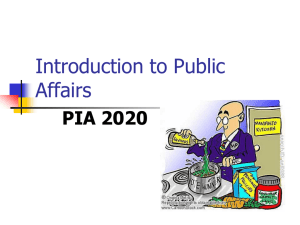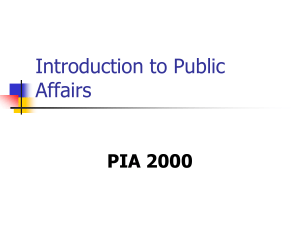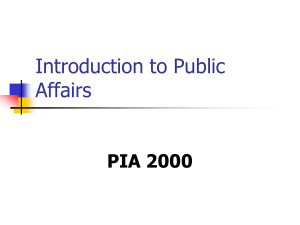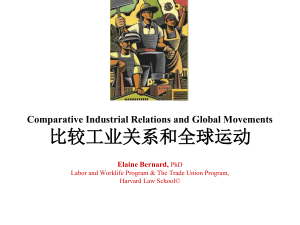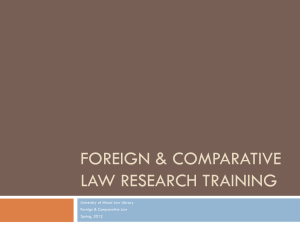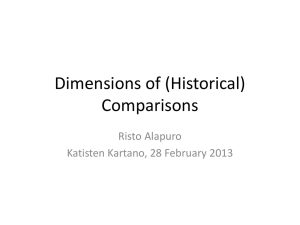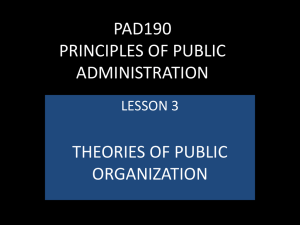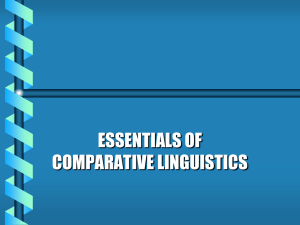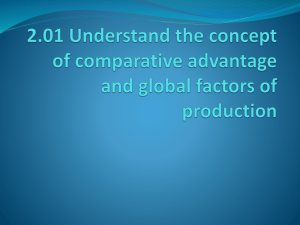Comparative Public Administration
advertisement
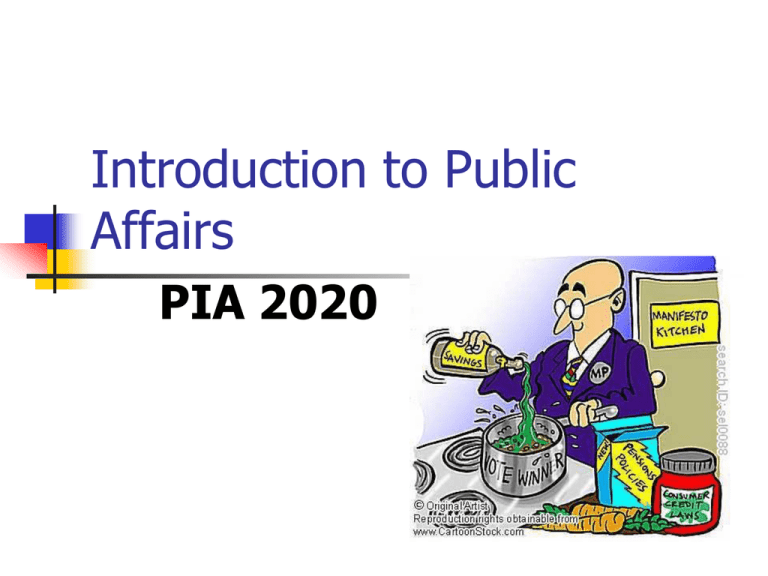
Introduction to Public Affairs PIA 2020 A. Course Overview: Goals This course focuses on the role of governance and governments both in the contemporary world as well as in its historic context. It is comparative and international in its approach but includes a major discussion of the U.S. case study. (Approx. 1/3 of content). Over the next semester, we will consider a number of broad issues. It is critical for each of you to begin to tie these together in your own mind. A. Overview of this Session A. Course Overview B. Central Debate C. Overview of Themes and Historical Legacy D. Enduring Features of Governance and Methods Overview, Continued E. Contemporary Policy Issues F. Public Sector Debate: Weber vs. Marx G. General and Enduring Features H. Comparative Approach and Culture I. Influences on the Policy Making Process Course Overview Class Introductions and Course Overview: Danielle LoustauWilliams Role of the Co-Instructor Discussion Sessions Class Members Introduction: Name, degree, background, future plans Assignment: One page biography with picture written in the third person Also need on bio: e-mail address and phone number Mechanics Picard Website: www.pitt.edu/~picard/ Reading Assignments: Discussion from Syllabus Course Requirements from the Syllabus (Including PhD students) Course Methodology- 1 Instruction Role of Instructors That of a “Coach” to support efforts to support efforts to pass exams based primarily on readings Two tests (Unannounced) and a scheduled final exam Methodology-2: Enduring Features Goal: Search for General Enduring Features of Governance in Public Affairs Can Allow for comparison of politicians, bureaucracies, structures and systems of Organizations and Institutions (governmental and non-governmental) Methodology- 3: Citizenship Public organizations affect all of us- as potential employees, clients or citizens. The course material is designed to raise as many questions as it answers. Methodology- 4: Themes In order to facilitate this "intellectual disorder" the course will be conducted as a mixture of lecture and structured discussion. Vigorous participation in discussion will be a plus in final grade Methodology 5: Management Issues Understanding Modern Management It is no longer just the effective administration of people In addition, it is the negotiation and linkages of partnership relations external to organizations Michael Phelps (Olympic) Swimmer Your Knowledge of Public Affairs After the Course Methodology 6- Comparative Methodology and the Readers Digest Approach Compare different areas or systems Compare different times Compare different systems at the same time Compare different processes The Importance of Time: Advert. Circa.1940 B. Central Debate: Two Giants of Public Affairs and Public Service Max Weber- Both a social scientist and a politician 1. Concern for Values: So-called Protestant Ethic 2. Separation of bureaucracy and politics 3. Weimar Republic- Political Institutions Karl Marx- Both a social scientist and a revolutionary 1. Class- Dialectic Materialism (History) 2. Social and Withering Away of State 3. Russian Revolution After his Death Maximilian Carl Emil Weber (21 April 1864 – 14 June 1920)- The Big Man As a Social Scientist Karl Heinrich Marx (May 5, 1818-March 14, 1883) HISTORY: Marx Roman SlaveryCitizens vs. Slaves FeudalismCapitalismBourgeoisie vs. Proletariat SocialismDictatorship of the Proletariat Communism The Dialectic and Historical Materialism The Importance of “Modern Times”- A Theory of Organizations Comparative Public Policy and Administration: Public Affairs C. Overview of Themes and Historical Legacy Mega-Theme: Order vs. Economic Management Public Affairs and Public Policy Historical Legacy The great organizations that do the work of modern states and their counterparts in the private and non-profit sector had their counterparts throughout history. Great Organizations? Historical Parallels The powerful Asian empires especially of China and India. The Ottoman Turks, African, Amerindian Kingdoms Especially in the King's services in Prussia, France, England and other European states. Songhai Empire, c.1340– 1591 Historical Legacy- 2 Modern comparisons are possible across the deepest divisions of system types (Developed vs. Under-development). Between authoritarian and pluralist systems, industrialized and developing systems and secular and religious regimes. Classification of the countries by developing status. Blue - developed countries Green - developing countries Red - underdeveloped countries Bureaucracy and Power The control of bureaucratic power, upon which comparisons of diverse bureaucracies can be valid. The Use of History: Historical Kingdoms in Asia, Africa and Europe all precursors to modern state system Recruitment? D. Enduring Features of Government and Comparative Methodology-1 Patterns of organization Recruitment of bureaucrats Certain common programs of governments Problem of Dysfuncton An Early Bureaucrat Basher Franz KafkaMan About Prague (July 3, 1883June 3, 1924) Enduring Features-2 Capacities and performance The perennial tensions between official (and) Personal norms and the control of bureaucratic power (Corruption) Rutherford B. Hays, 1877-1881 (Indian Affairs) Comparative Public Affairs Issues These include ways in which administrators interact with their political environment and influence the policy making process. We will also examine several specific administrative problems that have themselves become contentious policy issues Governance in Bangladesh E. Contemporary Policy Issues-1 Democracy and Public Policy- Representation Historical vs. Contemporary Models: Law and Order vs. Economic and Social Policy Governance and Political Economy- Who gets what when and how Recruitment- affirmative action and representative bureaucracy Regulation and Deregulation- Privatization and Contracting Out International Public Policy: The Extractive Industries Transparency Initiative- International Monetary Fund (IMF)- An Example Contemporary Policy Issues-2 Organizations, Socialization and Motivation- Status and Role Theory budgetary decision making- The Fiscus government reorganization- Public Sector Reform Decentralization- Grassroots and Local Governance Civil Society and Social Capital- Pluralism vs. Corporatism International Development and Foreign Aid- and Foreign and Security Policy - The Three D’s (Defense, Diplomacy and Development ”The Purpose of the Geographic Commands is the "3D" goals (the merging of defense, diplomacy and development)” Referenced from: http://thomaspmbarnett.com/globlogization/tag/usmilitary?currentPage=2#ixzz1WQjbBYKE Break Time Ten Minute Break Revisit: Overview of this Session A. Course Overview B. Central Debate C. Overview of Themes and Historical Legacy D. Enduring Features of Governance and Methods Overview, Continued E. Contemporary Policy Issues F. Public Sector Debate: Weber vs. Marx G. General and Enduring Features H. Comparative Approach and Culture I. Influences on the Policy Making Process Contemporary Issue: Privatization and the Political Economy In the last decade, critics of the public service have argued that efficient government is small government. Privatization has been the order of the day. Eg. Private Security Blackwater? President International Stability Operations Association, Doug Brooks, GSPIA PhD Alum Privatization: Contracting and non-profits This "neo-classical" model of development has been exported overseas, especially to the less developed and transitional states in Africa, Asia, Eastern and Central Europe and Latin America. Privatization? MCRO-ISSUE F. The Public Sector and Development- Weber vs. Marx One of the major goals of this course will be to examine this issue (Law and Order vs. Social and Economic Change) and Examine the role that the bureaucracy has played in the development process in Europe, the states of the former Soviet Union, the United States and the newly industrializing states of East Asia, Africa and Latin America. International Development Human Security: The Lord’s Resistance Army Public Policy and Management Comparative Public Affairs (PA) and Administration: “Five Minute History”- A Preview Preliminary Comments: 1. The History and Public Affairs The Passage of Time is Important 2. The view from the rest of the world. That includes the U.S. 3. A discipline that is not 4. Origins in the Comparative Politics Movement Goals: Macro-Issue a. Avoid the Use of case studies: some form of "theory building" b. Go beyond a narrow culture bound definition of P.A.- The American Case Study (a no-no) c. Focus on administrative systems and esp. the bureaucracy as a common governmental institution in political systems with widely differing decisionmaking patterns G. General and Enduring Features, Redux Patterns of organization, certain common programs of governments, capacities and performance in society Focus: Public Policy and Management and Organizational Dynamics Label: Public Administration Author of the Day: PITT’s B. Guy Peters Definition from Peters 1. Public Administration- Rule Application 2. Bureaucracy- Hierarchical organizations designed to utilize the enforcement of universal and impersonal rules to maintain authority 3. Public Policy- Key: Rule making as well as rule application More Cynical View Peters Thesis dissected Thesis- Attacks the artificial dichotomy between politics and administration Problem- critics of "rational bureaucracy" say it is the end of politics eg. End of "all the kings men“ A Great Film The perennial tensions between official and personal norms in organizations The issue of the "bureaucratic experience," (Hummel), that differs from the social (human) experience Hummel says "dehumanizing“ Standards and policies defined by the past and standardized for all e. g. people as cases Bureaucrat Bashing Bureaucrat Bashing as a Problem? Bureaucracy, Organizations and Power The control of bureaucratic power, upon which comparisons of diverse bureaucracies can be valid. Reminder- The Use of History: Historical Kingdoms in Asia, Africa and Europe precursor to modern state system Critique: The So-called Nanny State H. Comparative Approach and Culture So far so good…. The Problem- Definition as the beginning of confusion 1. Method vs. Area Problem 2. Strict definition: A method for crossnational comparison of bureaucratic structure or administrative behavior. Subfield of Comparative Politics 3. Often used as all public administration which is not American One Example: Colonial Administration The Importance of the Comparative Approach Cultural Dimension Contingency Approach (orgs. for prisons vs. research) Effects of diffusion- colonies and the world bureaucratic system Implementation- Hopes that are dashed in Oakland The Critical Issue of Culture Nature of Interaction Access: 1. Access to government often through the bureaucracy 2. Nature of interaction a. Ascription vs. achievement b. Values re. social and economic change Ascription What is the dominant cultural value in Terms of Access? a. Representation vs. achievement b. Values re. social and economic change or distribution c. What is the dominant cultural value? What is most important? d. Representation vs. Politics I. Influences on the Policy Making Process 1. In terms of operational rules as administrative regulations (objective outputs- Peters) 2. Traditional or habitual actions (subjective impacts on clients) 3. IdentifyAdministrativeProblems that become policy issues (eg. Corruption) 4. The debate about representation and participation Key: Issue of Relationship between government and the economy. Issue of Privatization (Again) Public-Private Partnerships- Including NGOs (The new buzz word). Note: John Armstrong's argument that education and training are critical variables in understanding “development" strategies in Western Europe and then Soviet Union UNITED STATES DEPARTMENT OF TRANSPORTATION REPORT TO CONGRESS ON PUBLIC-PRIVATE PARTNERSHIPS The Development Model Thus importance of the Chambers Johnson book on MITI (Note: PhD Students) Japan as a "state guided Market economy“ Thesis- Economic Development involved an expansion of the official bureaucracy By Indirection- Focus on Africa, Caribbean, Latin America, South Asia and the Middle East Ministry of International Trade and Industry and the Asia Model Comparative Public Management and Development: Macro-Theme Three Companion to Issues of Development Theory, Policy, and Planning Critical to an understanding of International Relations and Security Policy Summary: Comparative PA 1. Comparative View of Public Affairs and Management and Relationship to the Policy Process 2. The role of the bureaucracy in politics- Bureaucrats do make policy 3. The relationship between the state, the state bureaucracy to non-profit organizations and economic development. Review of Issues Questions and Comments?
